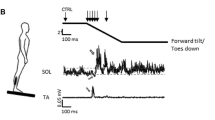Abstract
The purpose of this study was to investigate how gravity level affects the excitability of the soleus muscle (SOL) motoneuron pool to Ia afferent input while erect posture is maintained in humans. Three healthy male subjects participated in an experiment whereby three different gravity conditions [microgravity (MG), normal gravity (NG), and hypergravity (HG)] were imposed using a parabolic flight procedure. The SOL H-reflex was evoked every 2 s while the subjects kept an erect posture. The stimulus intensity was controlled automatically on a real-time basis by personal computer to induce the constant amplitude of M-wave (10±5% of maximal M-wave amplitude). The background electromyographic activity (BGA) of the SOL was largest during HG, while it was almost absent during MG. The SOL H-reflex amplitude was significantly larger during HG and MG than during NG (P<0.05). During NG and HG, there was a linear relationship between the BGA and the H-reflex amplitude; the difference in the SOL H-reflex amplitude between both gravity conditions could be explained in terms of the BGA level. However, during MG, despite the absence of BGA, the SOL H-reflex amplitude was larger than that during NG. Furthermore, when the subjects voluntarily activated the SOL by applying a load to the lower limb joints and spine by pulling a handle upward, this H-reflex enhancement almost disappeared. These results suggest that the somatosensory systems detecting a load at the lower limbs and/or vertebral column might play a role in reducing the excitability of the SOL motoneuron pool to Ia afferent inputs by presynaptic inhibition.




Similar content being viewed by others
References
Aiello I, Rosati G, Serra G, Tugnoli V, Manca M (1983) Static vestibulospinal influences in relation to different body tilts in man. Exp Neurol 79:18–26
Capaday C, Stein RB (1986) Amplitude modulation of the soleus H-reflex in the human during walking and standing. J Neurosci 6:1308–1313
Crone C, Nielsen J (1989) Methodological implications of the post activation depression of the soleus H-reflex in man. Exp Brain Res 78:28–32
Dietz V (1992) Human neuronal control of automatic functional movements: interaction between central programs and afferent input. Physiol Rev 72:33–69
Dietz V, Horstmann GA, Trippel M, Gollhofer A (1989) Human postural reflexes and gravity: an underwater simulation. Neurosci Lett 106:350–355
Ferris DP, Aagaard P, Simonsen EB, Farley CT, D-Poulsen P (2001) Soleus H-reflex gain in humans walking and running under simulated reduced gravity. J Physiol 530:167–180
Fleiss JL (1986) The design and analysis of clinical experiments. Wiley, New York
Gregory JE, Wood SA, Proske U (2001) An investigation into mechanisms of reflex reinforcement by the Jendrassik manoeuver. Exp Brain Res 138:366–374
Hayashi R, Tako K, Tokuda T, Yanagisawa N (1992) Comparison of amplitude of human soleus H-reflex during sitting and standing. Neurosci Res 13:227–233
Horak FB, Macpherson JM (1996) Postural orientation and equilibrium. In: Rowell LB, Shepherd JT (eds) Handbook of physiology, section 12. Exercise: regulation and integration of multiple systems. American Physiological Society, Oxford University Press, New York, pp 255–292
Hultborn H, Meunier S, Morin C, Pierrot-Deseilligny E (1987a) Assessing changes in presynaptic inhibition of Ia fibres: a study in man and the cat. J Physiol 389:729–756
Hultborn H, MeunierS, Pierrot-Deseilligny E, Shindo M (1987b) Changes in presynaptic inhibition of Ia fibres at the onset of voluntary contraction in man. J Physiol 389:757–772
Katz R, Meunier S, Pierrot-Deseilligny E (1988) Changes in presynaptic inhibition of Ia fibres in man while standing. Brain 111:417–437
Knikou M, Conway BA (2001) Modulation of soleus H-reflex following ipsilateral mechanical loading of the sole of the foot in normal and complete spinal cord injured humans. Neurosci Lett 303:107–110
Koceja DM, Kamen G (1992) Contralateral influences on triceps surae motoneuron excitability. Electroencephalogr Clin Neurophysiol 85:177–182
Koceja DM, Trimble MH, Earles DR (1993) Inhibition of the soleus H-reflex in standing man. Brain Res 629:155–158
Koceja DM, Markus CA, Trimble MH (1995) Postural modulation of the soleus H reflex in young and old subjects. Electroencephalogr Clin Neurophysiol 97:387–393
Mynark RG, Koceja DM, Lewis CA (1997) Heteronymous monosynaptic Ia facilitation from supine to standing and its relationship to the soleus H-reflex. Int J Neurosci 92:171–186
Stein RB (1995) Presynaptic inhibition in humans. Prog Neurobiol 47:533–544
Tokuda T, Tako K, Hayashi R, Yanagisawa N (1991) Disturbed modulation of the stretch reflex gain during standing in cerebellar ataxia. Electroencepharogr Clin Neurophysiol 81:421–426
Zehr EP, Stein RB (1999) Interaction of the Jendrassik maneuver with segmental presynaptic inhibition. Exp Brain Res 124:474–480
Acknowledgements
This study was supported in part by 'Ground Research for Space Utilization' promoted by NASDA and Japan Space Forum and by Health Sciences Research Grants from the Ministry of Health, Labor and Welfare.
Author information
Authors and Affiliations
Corresponding author
Rights and permissions
About this article
Cite this article
Miyoshi, T., Nozaki, D., Sekiguchi, H. et al. Somatosensory graviception inhibits soleus H-reflex during erect posture in humans as revealed by parabolic flight experiment. Exp Brain Res 150, 109–113 (2003). https://doi.org/10.1007/s00221-003-1414-8
Received:
Accepted:
Published:
Issue Date:
DOI: https://doi.org/10.1007/s00221-003-1414-8




